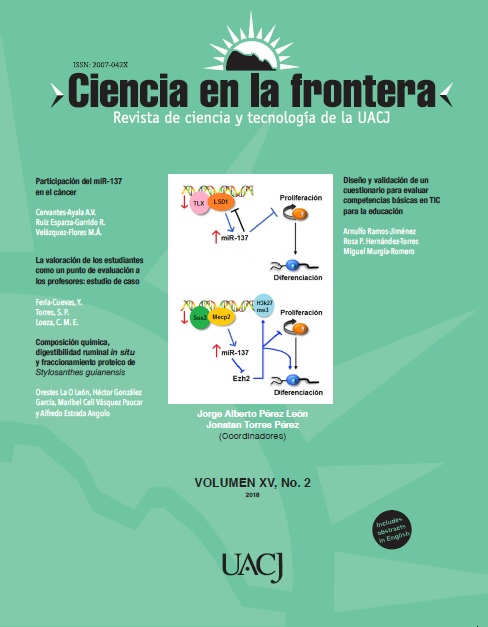Participación del miR-137 en el cáncer
Keywords:
microRNAs, miR-137, neurogenesis, cancerAbstract
MicroRNAs are small RNAs (18-100 nucleotides), which regulate the expression of their target genes at the post-transcriptional level; however, miRNAs have been detected at the nuclear level. MicroRNA hsa-mirR-137 is located within its host gene MIR137HG, in the locus 1p21.3, and regulates genes involved in cell proliferation and cell differentiation. This microRNA participates on the neurogenesis by suppressing the proliferation of neural stem cells and by promoting their differentiation. Because of these crucial functions, its participation has been focussed on the study of different neurological diseases and in cancer, where it functions as tumoral suppressor (nervous system tumors, melanoma, gastric and lung cancer, oral carcinoma, osteosarcoma, ovarian and breast cancer) or oncogene (bladder and breast cancer). According to these studies, miR-137 could function as a biomarker for diagnosis and prognosis, and as therapeutic target in many types of cancer; however, more studies are needed to establish these.References
Chang, X., Zhang, H., Lian, S., & Zhu, W. (2016). miR-137 suppresses tumor growth of malignant melanoma by targeting aurora kinase A. Biochem Biophys Res Communs, 475(3), 251–256.
Chen, R., Zhang, Y., Zhang, C., Wu, H., & Yang, S. (2017). miR-137 inhibits the proliferation of human non-small cell lung cancer cells by targeting SRC3. Oncol Lett, 13(5), 3905–3911.
Daugaard, I., & Hansen, T. B. (2017). Biogenesis and Function of Ago-Associated RNAs. Trends Genet, 33(3), 208–219.
Du, Y., Chen, Y., Wang, F., & Gu, L. (2016). miR-137 plays tumor suppressor roles in gastric cancer cell lines by targeting KLF12 and MYO1C. Tumour Biol, 37(10), 13557–13569.
Feng, Q., Wu, Q., Liu, X., Xiong, Y., & Li, H. (2017). MicroRNA-137 acts as a tumor suppressor in osteosarcoma by targeting enhancer of zeste homolog 2. Exp Ther Med, 13(6), 3167–3174.
Hansen, T. B., Venø, M. T., Jensen, T. I., Schaefer, A., Damgaard, C. K., & Kjems, J. (2016). Argonaute-associated short introns are a novel class of gene regulators. Nat Commun, 7(May), 1–10.
Kwak, P. B., Iwasaki, S., & Tomari, Y. (2010). The microRNA pathway and cancer. Cancer Sci, 101(11), 2309–2315.
Li, H., Li, Y., Li, Y., Shi, X., & Chen, H. (2016). Circulating microRNA-137 is a potential biomarker for human glioblastoma, Eur Rev Med Pharmacol Sci, 20, 3599–3604.
Li, X., Chen, W., Zeng, W., Wan, C., Duan, S., & Jiang, S. (2017). microRNA-137 promotes apoptosis in ovarian cancer cells via the regulation of XIAP. Br J Cancer, 116(1), 66–76.
Luo, C., Tetteh, P. W., Merz, P. R., Dickes, E., Abukiwan, A., Hotz-Wagenblatt, A. Eichmüller, S. B. (2013). miR-137 Inhibits the Invasion of Melanoma Cells through Downregulation of Multiple Oncogenic Target Genes. J Invest Dermatol, 133(3), 768–775.
Mahmoudi, E., & Cairns, M. J. (2017). MiR-137: an important player in neural development and neoplastic transformation. Mol Psychiatry, 22(1), 44–55.
Nikonova, A., Astsaturov, I., Serebriiskii, I., Dunbrack, R., & Golemis, E. (2008). Aurora-A kinase (AURKA) in normal and pathological cell growth. Cell Mol Life Sci, 70(4), 661–687.
Rana, T. M. (2007). Illuminating the silence: Understanding the structure and function of small RNAs. Nat Rev Mol Cell Biol, 8(1), 23–36.
Ruiz Esparza-Garrido, R. & Velázquez-Flores, MÁ. (2016). Nuevos e inesperados mecanismos de biogénesis y acción de los microRNAs. Revista de Educación Bioquímica, 35(3), 55–70.
Sato, F., Tsuchiya, S., Meltzer, S. J., & Shimizu, K. (2011). MicroRNAs and epigenetics. FEBS Journal, 278(10), 1598–1609.
Smrt, R. D., Szulwach, K. E., Pfeiffer, R. L., Li, X., Guo, W., Pathania, M., Bordey, A. (2011). MicroRNA miR-137 regulates neuronal maturation by targeting ubiquitin ligase Mind Bomb-1. Mind, 28(6), 1060–1070.
Sun, G., Ye, P., Murai, K., Lang, M.-F., & Li, S. (2011). miR-137 forms a regulatory loop with nuclear receptor TLX and LSD1 in neural stem cells. Nat Rev Mol Cell Biol., 2:259(1).
Sun, L., Liang, J., Wang, Q., Li, Z., Du, Y., & Xu, X. (2016). MicroRNA-137 suppresses tongue squamous carcinoma cell proliferation, migration and invasion. Cell Prolif, 49(5), 628–635.
Szulwach, K. E., Li, X., Smrt, R. D., Li, Y., Luo, Y., Lin, L., Jin, P. (2010). Cross talk between microRNA and epigenetic regulation in adult neurogenesis. J Cell Biol., 189(1), 127–141.
Takahashi, R. U., Miyazaki, H., & Ochiya, T. (2015). The roles of microRNAs in breast cancer. Cancers, 7(2), 598–616.
Tamim, S., Vo, D. T., Uren, P. J., Qiao, M., Bindewald, E., Kasprzak, W. K., Penalva, L. O. F. (2014). Genomic analyses reveal broad impact of miR-137 on genes associated with malignant transformation and neuronal differentiation in glioblastoma cells. PLoS ONE, 9(1).
Valencia-Sanchez, M. A., Liu, J., Hannon, G. J., & Parker, R. (2006). Control of translation and mRNA degradation by miRNAs and siRNAs. Genes Dev, 20(5), 515–524.
Vincent, K., Pichler, M., Lee, G. W., & Ling, H. (2014). MicroRNAs, genomic instability and cancer. Int. J. Mol. Sci, 15(8), 14475–14491.
Wahid, F., Shehzad, A., Khan, T., & Kim, Y. Y. (2010). MicroRNAs: Synthesis, mechanism, function, and recent clinical trials. Mol Cell Res, 1803(11), 1231–1243.
Warburton, A., Breen, G., Rujescu, D., Bubb, V. J., & Quinn, J. P. (2015). Characterization of a REST-regulated internal promoter in the schizophrenia
genome-wide associated gene MIR137. Schizophr
Bull, 41(3), 698–707.
Winter, J., Jung, S., Keller, S., Gregory, R. I., &
Diederichs, S. (2009). Many roads to maturity: microRNA
biogenesis pathways and their regulation.
Nat Cell Biol, 11(3), 228–234.
Xiu, Y., Liu, Z., Xia, S., Jin, C., Yin, H., Zhao, W., &
Wu, Q. (2014). MicroRNA-137 upregulation increases
bladder cancer cell proliferation and invasion by
targeting PAQR3. PLoS ONE, 9(10), 1–7.
Yin, J., Lin, J., Luo, X., Chen, Y., Li, Z., Ma, G., &
Li, K. (2014). MiR-137: A new player in schizophrenia.
Int J Mol Sci, 15(2), 3262–3271.
Ying, X., Sun, Y., & He, P. (2017). MicroRNA-137
inhibits BMP7 to enhance the mesenchymal transition
of breast cancer cells. Oncotarget, 8(11), 18348–
Zhao, Y., Li, Y., Lou, G., Zhao, L., Xu, Z., Zhang,
Y., & He, F. (2012). MiR-137 targets estrogen-related
receptor alpha and impairs the proliferative and migratory
capacity of breast cancer cells. PLoS ONE,
(6).


